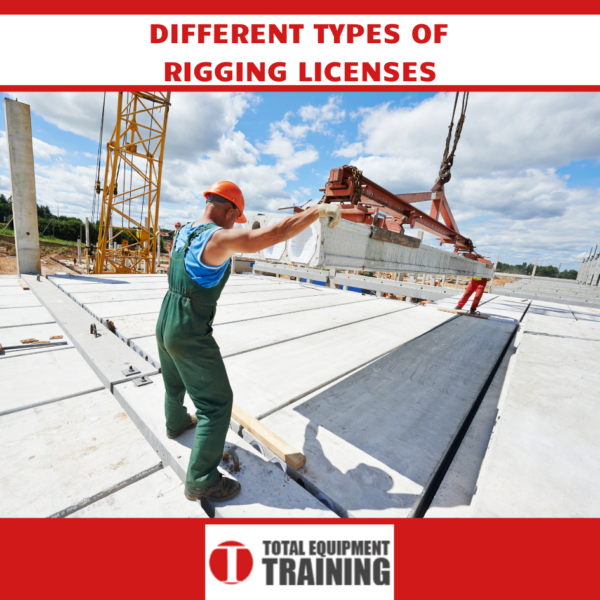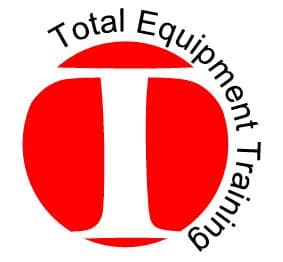
With the expansion and development of both the construction and heavy industries, it has become more necessary to move heavier and heavier loads more often. Heavy equipment is used to easily shift or load general materials such as soil or gravel to trucks for transport. However, a very specific piece of equipment, the rigger, helps move or lift loads that can be damaged or cause damage on impact (such as glass or concrete piping).
What Is Rigging?
Rigging and riggers have a few different meanings and context. However, what is rigging in construction?
In the construction industry, rigging is used to refer to both:
- The apparatus which is used to move and/or lift a load
- The act of setting up equipment to safely move and/or lift a load.
Total Equipment Training offers many free online resources for rigging operators. Click here to take the Rigger 1 practice test.
Why rigger training is important
What Are the Different Types of Rigging Equipment?
The proper and safe type of rigging equipment to use depends on the nature of the load, and the machine being used to lift it, such as a crane. The main categories of riggers used to securely attach the load are:
- Blocks and Pulleys
- Eye Bolts
- Rigging Hooks
- Wire Ropes
- Spreader Bars/Lifting Beams
- Slings
- Shackles and Turnbuckles
This equipment comes in a variety of materials and sizes fit for different uses. They are often used in combination with each other to safely and efficiently attach the load to the moving apparatus. A certified rigger has the skills and competencies to know which equipment would work best for specific work setups.
Schedule Rigging Equipment Training
Classes of High-Risk Work License for Rigging Work
Work in the construction and heavy industries is among one of the most hazard-prone fields of employment. Realizing this, safety regulation bodies and governments across the world have thus classified all high-risk jobs to require licensing. The three that apply to rigging are:
Basic Rigging
This introductory level teaches the use of common rigging hardware. Trainees are also guided on creating work plans and carrying out inspections. Other areas trained on include:
- Structural steel erection
- Placement of precast concrete
- Perimeter safety screens and shutters
- Cantilevered crane-loading platforms
- Safety nets and static lines

Intermediate Rigging
In this level, trainees will improve on their skills learned in Basic Rigging, which is also the prerequisite before starting Intermediate Rigging. Intermediate Rigging covers:
- Rigging of all hoist types
- Rigging cranes, conveyors and excavators
- Demolition of structures
- Dual lifts
- Tilt slabs
Advanced Rigging
This topmost tier equips the trainee with advanced rigging skills, built on the foundations of earlier training. Areas covered include:
- Setup for gin poles and shear legs
- Flying foxes and cableways
- Work with suspended scaffolds and hung scaffolds
- Guyed derricks and structures
Throughout these stages, various safety measures are taught, but not emphasized on. It is therefore advisable to reach out for rigger training for a greater focus on safety and protocol awareness. Call TET to schedule rigger training: (610) 321-2679
Why Are Rigging Courses Important and Why You Should Do It?
Before any worker is officially allowed to undertake any kind of rigging work, it is suggested that they hold a Rigger Certification from a recognized training organization such as the NCCCO (National Commission for the Certification of Crane Operators) and the subsequent license issued.
With a nationally recognized training, certification and licensing, it becomes easier to find placement as a rigger, thanks to the evidence of proficiency. Advancing from Rigger 1 into higher levels of rigger training (Intermediate, Advanced) and certification (Certified Rigger Level 2) also avails opportunities to earn more income and work with high-level professionals in the sector.
Choosing TET for your Rigger Certifications
Rigging equipment includes OSHA compliant operators to manage a worksite safely. Total Equipment Training is an experienced and qualified organization that offers training at various levels for professionals in the construction and heavy equipment industry.
Our skilled and expert rigger trainers are ready to take you and/or your rigging team to the next level by providing qualitative training from industry professionals while partnering with major players in the field. Reach out today and begin the journey to a safer and more efficient work site.

